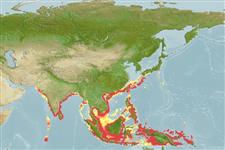Ikan bertulang rawan (sharks and rays) >
Orectolobiformes (Carpet sharks) >
Hemiscylliidae (Bamboo sharks)
Etymology: Chiloscyllium: cheilos (Gr.), lip, referring to membranous and broad lower lip, presumably of C. plagiosum (proposed without a species); skylion, Greek for dogfish or small shark. (See ETYFish); indicum: -icus (Gr.), belonging to: Indian Ocean, type locality. (See ETYFish).
More on author: Gmelin.
Environment: milieu / climate zone / depth range / distribution range
Ekologi
laut; air tawar; payau dasar (demersal); oceanodromus (Ref. 51243); kisaran kedalaman 0 - 90 m (Ref. 106604). Tropical; 40°N - 10°S, 65°E - 160°E
Indo-West Pacific: India, Sri Lanka, to about Bangladesh; possibly Arabian Sea, and around Thailand and Indonesia (Sumatra). Records from Solomon Islands and north to China and Japan are different species, possibly Chiloscyllium plagiosum.
Length at first maturity / Size / Weight / umur
Maturity: Lm ?, range 43 - ? cm
Max length : 65.0 cm TL jantan/; (Ref. 247)
Duri punggung (Keseluruhan (total)): 0; duri punggung lunak (Keseluruhan (total)): 0; Duri dubur 0; Sirip dubur lunak: 0. Genus: Nostrils subterminal on snout; pre-oral snout long, mouth closer to eyes than snout tip; eyes and supraorbital ridges hardly elevated; no black hood on head or large spot or spots on sides of body above pectoral fins (Ref. 43278). Caudal fin with a pronounced subterminal notch but without a ventral lobe (Ref. 13575).
Species: Light brown above, cream below, with numerous dark spots on body, tail, and fins, these often forming indistinct vertical bars and saddles (Ref. 31575). Dermal ridge on middle of back and two low lateral ridges (Ref. 4832).
A common, but little-known inshore sluggish bottom shark (Ref. 13575) found on sandy and muddy bottoms of coastal waters, bays and inlets and rocky and coral reefs. Probably mainly feeds on bottom-dwelling invertebrates (Ref. 13575), also small fishes. Oviparous (Ref. 50449). Utilized for human consumption (Ref. 247). Possibly may occur in fresh water in the lower reaches of the Perak River in peninsular Malaysia (Ref. 43278).
Life cycle and mating behavior
Kematangan | Reproduksi, perkembang biakan | Pemijahan | telur-telur | Fecundity | Larva
Oviparous, deposits eggs in small, oval egg cases on the bottom (Ref. 247). Paired eggs are laid. Embryos feed solely on yolk (Ref. 50449). Distinct pairing with embrace (Ref. 205).
Compagno, L.J.V., 1984. FAO Species Catalogue. Vol. 4. Sharks of the world. An annotated and illustrated catalogue of shark species known to date. Part 1 - Hexanchiformes to Lamniformes. FAO Fish. Synop. 125(4/1):1-249. Rome, FAO. (Ref. 247)
Status IUCN Red List (Ref. 130435)
ancaman kepada manusia
Harmless
penggunaan manusia
Perikanan: komersial
informasi lanjut
AcuanBudidaya airprofil budidaya airStrainGenetikaElectrophoresesDiturunkanPenyakit-penyakitPengolahanNutrientsMass conversion
mitraGambarStamps, Coins Misc.Suara-suaraCiguateraKecepatanTipe renangArea insangOtolithsOtakPenglihatan / visi
Alat, peralatan
laporan khas
muat turun XML
Sumber internet
Estimates based on models
Preferred temperature (Ref.
123201): 25.8 - 29.3, mean 28.8 °C (based on 1477 cells).
Phylogenetic diversity index (Ref.
82804): PD
50 = 0.5039 [Uniqueness, from 0.5 = low to 2.0 = high].
Bayesian length-weight: a=0.00380 (0.00206 - 0.00702), b=3.14 (2.97 - 3.31), in cm total length, based on LWR estimates for this species & (Sub)family-body (Ref.
93245).
Trophic level (Ref.
69278): 4.0 ±0.60 se; based on food items.
Daya lenting (Ref.
120179): Rendah, Waktu penggandaan populasi minimum 4.5 - 14 tahun (Fec assumed to be <100).
Fishing Vulnerability (Ref.
59153): Moderate to high vulnerability (46 of 100).
